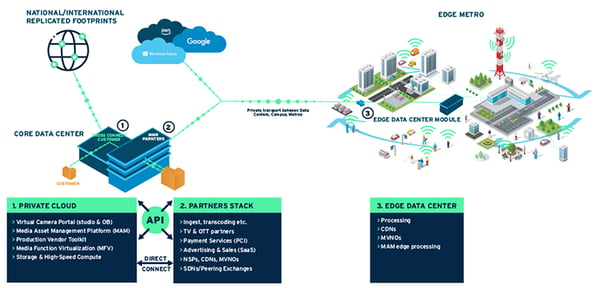Elevate the power of your work
Get a FREE consultation today!
From the brink to the edge: An overview of the current challenges, drivers and opportunities for Entertainment, Content and Media infrastructure.

From the brink to the edge: An overview of the current challenges, drivers and opportunities for Entertainment, Content and Media infrastructure.
This solution guide sets out the key drivers behind the rapid rollout of virtualized end-to-end media platforms, covering production, partnerships/supply chain opportunities and edge capabilities, and explains the critical role that colocation can play.
Learn more about:

Iron Mountain is a global data center company that provides tailored, sustainable, secure, carrier and cloud-neutral colocation solutions.
Iron Mountain provides supporting data center services, including our network operations center, smart remote hands, data center migration and more.
Get a FREE consultation today!
Covid hit the media and entertainment industries hard. In 2020, there was a 71% decline in box-office revenue. Live music revenues plunged by 74%. Total global entertainment and media revenue fell an unprecedented 4% (US$81.0bn).
In the face of this potential crash, streaming platform growth provided hope. Total data consumption increased 30% during the year, sparking a new, higher forecast growth trend. OTT video, video games and internet advertising showed above-average rises. While VR was the fastest-growing segment and shows the shape of things to come, streaming services, social media and gaming remain the core income drivers. There has been little bounce back since then, with consumption remaining high as the pandemic becomes endemic.
These twin pressures have brought many media businesses to a digital crossroads. Despite drops in revenue, decisive investment is now taking place to maintain uptime and performance. Virtualization is a necessity rather than a nice-to-have.
Digital architectures that used to be adequate now hold businesses back. ‘Pure-play’ digital operators are in the driving seat and this is forcing mixed businesses to restructure. Outsourced structures are an advantage, as automation and remote management put the onus on providers to deliver new capacity and services and allow a clearer focus on the core business in challenging times. As Netflix has demonstrated, the earlier the move to a virtual environment, the more flexible, streamlined, and scalable the business model will be. But public cloud costs more and can mean ceding control, so careful planning is required to get the right mix of private to public.



Enter your information to access the full content.